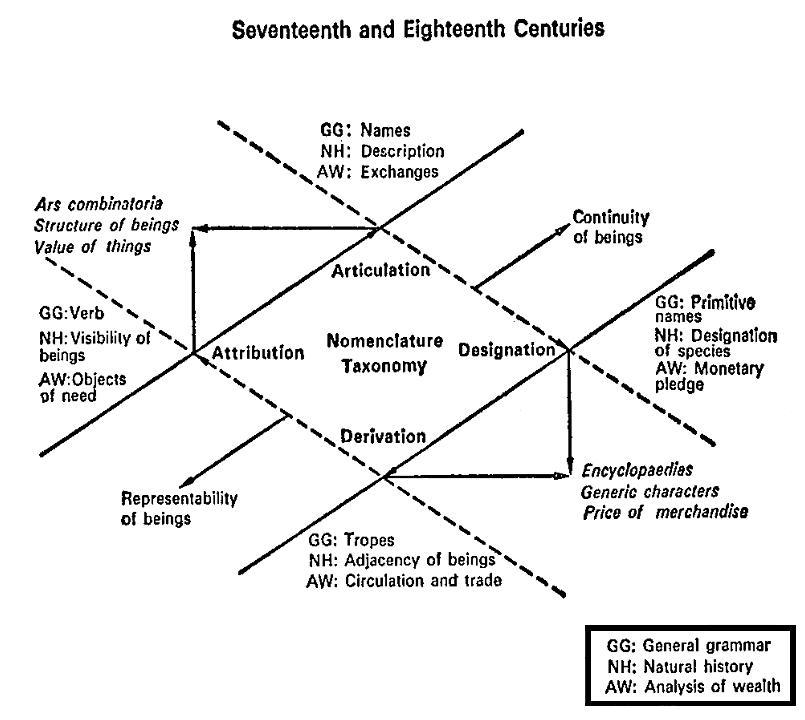You can say what you like about D and G (and these days people do), they certainly inspire diagramming. I thought it might be useful to bunch some of these together here. Not only are they often interesting diagrams, they often diagram diagramming. Of course, other workshoppers might consider the diagramming of other thinkers.
Here’s a diagram of Guattarian semiotics, from Gary Genosko’s Guattari Reader, via Janell Watson’s ‘Schizoanalysis as Metamodeling‘ in the exceedingly excellent Fibreculture Journal. It’s Guattari’s ‘Place of the signifier in the institution’ (from Félix Guattari, The Guattari Reader, edited by Gary Genosko: Oxford, UK: Blackwell, 1996, p. 149). Those who know me know I’m not an OOO’er but that doesn’t mean I don’t think this Larval Subject post on ‘Double Articulation: Notes Towards a Theory of the Genesis of Objects‘, which also includes the diagram below, isn’t interesting. It is!
 Here’s a Brian Holmes’ diagram of Guattari’s thinking, also found in his ‘ESCAPE THE OVERCODE: Guattari’s Schizoanalytic Cartographies, or the Pathic Core at the Heart of Cybernetics‘. This version is taken from a great post elsewhere by Anna Munster on ‘The image in the network’, ‘that attempts to work with the processual relations involved in the shaping of new subjectivities of collective enunciation’
Here’s a Brian Holmes’ diagram of Guattari’s thinking, also found in his ‘ESCAPE THE OVERCODE: Guattari’s Schizoanalytic Cartographies, or the Pathic Core at the Heart of Cybernetics‘. This version is taken from a great post elsewhere by Anna Munster on ‘The image in the network’, ‘that attempts to work with the processual relations involved in the shaping of new subjectivities of collective enunciation’
Here is a discussion of the rhizome and architecture. It contains this rather nice rhizome illustration—a complex diagram from many perspectives.

Here’s a diagram from Laura U. Marks site, which ‘synthesizes a monist aesthetics from Henri Bergson, Deleuze’s work on the fold, the philosophy of Deleuze and Guattari, the triadic logic of C.S. Peirce, medieval Isma‘ili thought on latency and manifestation, and Ibn Sînâ and Deleuze on the univocity of being’. More information here!

Here’s Sean Smith’s diagram of the molar and the molecular from his fabulous SportsBabel blog. It’s actually a diagram ‘theorizing basketball, written after reading Deleuze and Guattari’s A Thousand Plateaus: Capitalism and Schizophrenia.’

Meanwhile there’s a rather blurry version of the score with which the ‘Rhizome’ chapter of A Thousand Plateaus begins here. The rest of this post looks kind of interesting (although I haven’t read it really) … there are quite a few more diagrams. In fact, they seem to be everywhere.
The next link is to the famous Deleuze “Diagramme de Foucault”, with the fold and all. There’s the more famous panopticon diagram down the page. This is from one of my favourite blogs, Pirates and Revolutionaries, a post on ‘Foucault and Deleuze in Nikolas Rose’s “Authority and the Genealogy of Subjectivity’.
Here’s a machinic assemblages from another of my favourite blogs, Fractal Ontology. It’s a post on spectral realism, titled simply ‘Spectral.’ Among other things, this post discusses ‘pure diagrammatic force.’

From the Anarchist without Content blog we get Foucault’s 17th and 18th century version of the ‘Order of Things’.

If you go to this page, Beth Metcalf’s ‘Hjelmslev’s Univocity’, she diagrams de Saussure’s semiology versus Hjelmslev’s ‘semiotic net’.
And it’s really worth going to Mark Ngui’s drawings of the first two chapters of A Thousand Plateaus. That’s from the fabuously excellent Inflexions journal. There’s more here.
Here’s a 2007 post by Brian Holmes, ‘The Potential Personality: Trans-Subjectivity in the Society of Control‘. This has a great diagram of ‘initial characteristics of an artistic resistance to the control society’. And it also discusses the diagram of the swarm.
Finally here’s a great diagram on a blog post by DAYglo Writing. It’s really quite beautiful and I encourage you to go to the large version here. It’s diagramming an ‘energy island’ in relation to Guattari’s Three Ecologies. The project proposes ‘a new layer of decentralized systems that attempt to instigate new subjectivities through open source interaction. It starts with an independent, yet non-linear energy network. This network converges at separate hubs that then will contain new typologies for open source living’
 That seems a nice way to finish this post.
That seems a nice way to finish this post.


